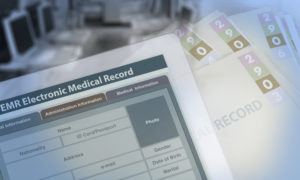By Charles B. Brownlow, OD

Increase your confidence that you accurately code and bill–and that your staff does, too. Consistently performing four key steps can protect you from insurance audits and increase reimbursements.
Keeping good medical records and coding correctly is not difficult nor complicated, yet many doctors are sloppy in their record-keeping and coding. This may result in being audited unnecessarily. I consult to many doctors and conduct what I call “friendly audits” to give them a sense of what to expect in a real audit. I often find shortcomings in accuracy in record-keeping and billing and coding.
Consider the following four key billing and coding principles that I have been teaching for 20 years. If you are not currently implementing these principles, or if you don’t understand them or feel you are weak in one or more of the principles, do something about it! Do a little research and reading. Ask a third-party source such as a consultant for help or another doctor who can mentor you in proper billing and coding. But do not go another week–much less another month, quarter or year–without confidence that your medical record keeping is sound and your choices of office visit and procedure codes are accurate.
1. Provide the care the patient needs…No more and no less! Carefully interview the patient at the beginning of the visit, and customize the case history to the apparent needs of the patient. As you finish the case history, design the physical examination to provide you with the information you need to deal with the patient’s unique needs on this unique day. “Cookie cutter” patient encounters, long the standard in eyecare, are passé and getting increasingly outdated. Insurers will not pay for histories, examinations, additional testing or medical decision-making that is not clearly substantiated by the needs of the patient that day.
Real life example: I have been involved in audits with doctors whose case histories were identical for multiple patients, even though the reasons for the visits were unique to each case. It is possible but unlikely that histories of present illness on 10 consecutive encounters for 10 unique patients would all be: “Two weeks duration, mild severity, both eyes, gets better with aspirin.” That theoretically qualifies as “extended” history of present illness, but it more likely leads to suspicion of incorrect coding and possibly fraud. If the case histories for consecutive patients were identical, we wouldn’t need doctors much, would we?
2. Keep a detailed, legible and accurate record of the history, examination and diagnoses that are pertinent to the patient on the day of the exam, and the management options that you choose to communicate to your patient, staff and other providers. The record should not be automatically populated by copying information from a previous visit. What are you, clairvoyant? Each visit is unique, and the record for the visit must be unique. Copying data from previous visits provides an opportunity for copying data for tests that you forget or otherwise neglect to do on the current visit. This is extremely dangerous in an audit and it is not necessary. Don’t do it.
Real life example: I have seen medical records that are clear and concise and readable from a distance of six feet, and I have seen records that are totally indecipherable, even by the doctor and staff! Whether the chart is hand-written or electronic, it is the doctor’s singular responsibility to be sure the record accurately reflects each patient’s needs and that the information is recorded in a legible, logical manner. You’re keeping records for the benefit of your patient and for the doctors and staff in your practice, to ensure that the care provided is appropriate and intentional. You are not keeping records for insurance company auditors, though doing a good job for the right reasons results in a much better experience with those auditors.
3. Choose codes based on the content of the record. Choosing codes is not a game to maximize reimbursement or an effort to provide the insurance company with the codes that they want to see. Just as diagnosis codes are customized to the patient’s conditions during each visit, the office visit codes and procedure codes for each visit should be unique and customized to the visit, based purely on the content of the record.
Real life example: By not taking the time and making the effort to learn how to choose codes and/or by not ensuring that one or more key staff people are trained to do it, doctors are likely to be choosing codes that are too high and too low; often at about equal frequency. In the friendly audits that my consultancy has done for ODs in the past year or so–10 charts per doctor–we find the average across the ten to be three levels low. That could mean that seven were coded correctly and three were coded one level low (e.g. 99213 when it earned a 99214). It could also mean (and often does) that three were coded one level too high (e.g. 99214 when the records earned 99213), six were coded one level low, and one was coded correctly. Choosing codes is not a matter of luck, nor is it a guessing game. Accuracy in coding is a matter of “grading” the level of the key components; case history, physical examination, medical decision-making; and choosing the office visit code based on CPT definitions and the Documentation Guidelines. With very little practice, the process takes less than one minute per record!
4. Submit the claim or superbill to the payer and/or patient based on the three principles listed above. Believe me, if you have done what the patient needed (no more, no less), have kept a good record of what you have done and have chosen all the codes based on the content of the record, an insurance company’s audit is nothing to fear. If you are a little (or a lot) weak on any of the first three principles, an audit can bring you to your knees and seriously deflate your bank account or worse!
Audits by Medicare and commercial insurers will happen, guaranteed! No one intends to pay for services that were not provided or to pay more for services than they are contracted to pay. Insurance companies are doing very well financially, and they have the resources to ensure that they will continue to do well. The only real defense that a provider has is to establish internal protocols to be sure that every patient is cared for properly, every medical record reflects the care the patient has received, and that every visit and procedure is coded accurately.
This would be a great time for you to stand up from your computer and go to the nearest mirror. Take a good look. Do you see a doctor confident that her/his patient records are thorough and accurate, whose choices of visit and procedure codes are accurate, objective and repeatable? If not, this is an excellent time to pledge to yourself that in the final weeks of 2011 you will learn and apply the simple rules of accurate coding.
Related ROB Articles
How to Coordinate Medical and Vision Plan Billing
Outsource HR and Billing to Improve Practice Quality and Efficiency
Use EHR to Optimize Billing and Coding Process
Charles B. Brownlow, OD, is an eyecare consultant as co-owner of PMI, LLC. To contact him: brownlowod@aol.com.

























